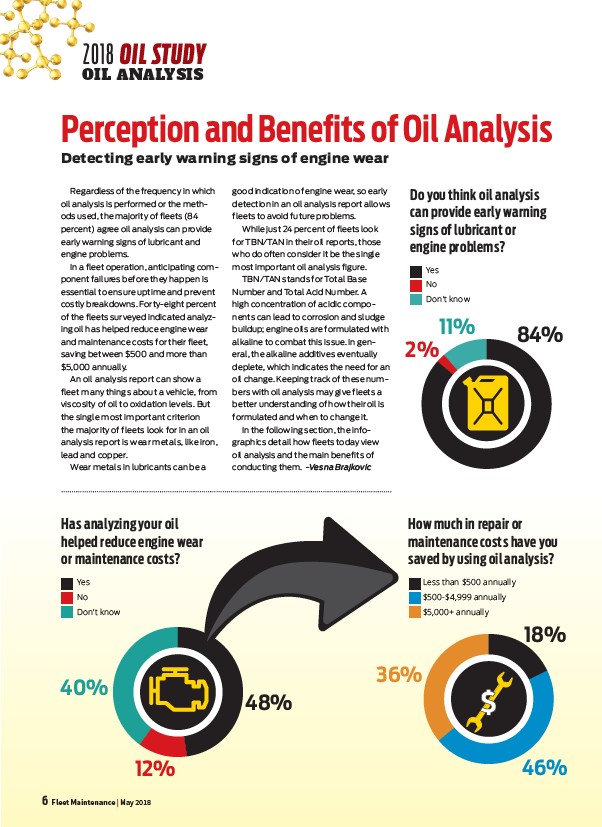
2018 OIL STUDY
OIL ANALYSIS
Perception and Benefi ts of Oil Analysis
Detecting early warning signs of engine wear
Regardless of the frequency in which
oil analysis is performed or the methods
used, the majority of fleets (84
percent) agree oil analysis can provide
early warning signs of lubricant and
engine problems.
In a fleet operation, anticipating component
failures before they happen is
essential to ensure uptime and prevent
costly breakdowns. Forty-eight percent
of the fleets surveyed indicated analyzing
oil has helped reduce engine wear
and maintenance costs for their fleet,
saving between $500 and more than
$5,000 annually.
An oil analysis report can show a
fleet many things about a vehicle, from
viscosity of oil to oxidation levels. But
the single most important criterion
the majority of fleets look for in an oil
analysis report is wear metals, like iron,
lead and copper.
Wear metals in lubricants can be a
6 Fleet Maintenance | May 2018
good indication of engine wear, so early
detection in an oil analysis report allows
fleets to avoid future problems.
While just 24 percent of fleets look
for TBN/TAN in their oil reports, those
who do often consider it be the single
most important oil analysis figure.
TBN/TAN stands for Total Base
Number and Total Acid Number. A
high concentration of acidic components
can lead to corrosion and sludge
buildup; engine oils are formulated with
alkaline to combat this issue. In general,
the alkaline additives eventually
deplete, which indicates the need for an
oil change. Keeping track of these numbers
with oil analysis may give fleets a
better understanding of how their oil is
formulated and when to change it.
In the following section, the infographics
detail how fleets today view
oil analysis and the main benefits of
conducting them. -Vesna Brajkovic
Has analyzing your oil
helped reduce engine wear
or maintenance costs?
Do you think oil analysis
can provide early warning
signs of lubricant or
engine problems?
How much in repair or
maintenance costs have you
saved by using oil analysis?
Yes
No
Don’t know
Less than $500 annually
$500-$4,999 annually
$5,000+ annually
48%
40%
12%
18%
36%
46%
Yes
No
Don’t know
84%
2%
11%